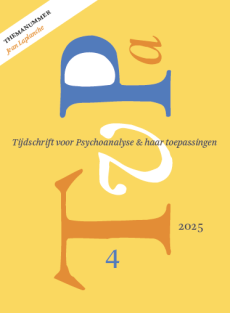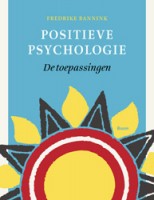Karakter, identiteit en subjectivering in de adolescentie
Summary
Character, identity and subjectivation in adolescence
Forty years ago Peter Blos and Erik Erikson published pioneering articles on adolescence, respectively in metapsychological terms of character the intrapsychic formation of an automatized structure of self-regulation and in terms of a then new psychoanalytical construct, identity. Both character and identity remain valuable concepts necessarily, however, in the context of a contemporary perspective. Since intrapsychic and intersubjective perspectives are both indispensable to an understanding of adolescent development, a dialectal approach is necessary.
Literatuur
- Becker, M. & Shalgi, B. (2006). Selfdetermination and intersubjectivity. Psychoanalytic Study of the Child, 61, 155-169.
- Berenstein, I. (2001). The link and the other. International Journal of Psychoanalysis, 82, 141-151.
- Blos, P. (1967). The second individuation process of adolescence. Psychoanalytic Study of the Child, 22, 162-187.
- Blos, P. (1968). Character formation in adolescence. Psychoanalytic Study of the Child, 23, 245-263.
- Bohleber, W. (1998). Psychoanalyse, Adoleszenz und das Problem der Identität. Psyche, 53, 507-529.
- Briggs, St. (2008). Working with adolescents and young adults. Londen: Palgrave Macmillan.
- Cahn, R. (1998). The process of becominga- subject in adolescence. In M. Perret- Catipovic & F. Ladame (red.), Adolescence and psychoanalysis (p. 149-160). Londen: Karnac Books.
- Cahn, R. (1999). Ladolescent dans la psychanalyse LAventure de la subjectivation. Parijs: Presses Universitaires de France.
- Cavell, M. (2006). Becoming a subject. Oxford: Oxford University Press.
- Erikson, E. (1968). Identity, youth and crisis. New York: Norton/Vertaling (1971): Identiteit Jeugd en crisis. Utrecht/Antwerpen: Het Spectrum.
- Fonagy, P. & Target, M. (2007). Playing with reality IV A theory of external reality rooted in intersubjectivity. International Journal of Psychoanalysis, 88, 917-939.
- Freud, S. (1908). Charakter und Analerotik. Studienausgabe IV (p. 25-30): Frankfurt: S. Fischer.
- Gutton, P. (1998). The pubertal, its sources and fate. In M. Perret-Catipovic & F. Ladame (red.). Adolescence and psychoanalysis (p. 133-148). Londen: Karnac Books.
- Kennedy, R. (2000). Becoming a subject Some theoretical and clinical issues. International Journal of Psychoanalysis, 81, 875-892.
- Mahler, M.S. (1975). The psychological birth of the human infant. New York: Basic Books.
- Ubbels, J. (2009). Etnische identiteit. In M. Thys & W. Gomperts (red.), Vergezichten Over transculturele psychoanalyse (p. 91-111). Antwerpen/Apeldoorn: Garant.
- Wallerstein, R.S. (1998). Eriksons concept of ego identity reconsidered. Journal of the American Psychoanalytic Association, 46, 229-247.
 © 2009-2025 Uitgeverij Boom Amsterdam
© 2009-2025 Uitgeverij Boom Amsterdam
ISSN 1382-516x
De artikelen uit de (online)tijdschriften van Uitgeverij Boom zijn auteursrechtelijk beschermd. U kunt er natuurlijk uit citeren (voorzien van een bronvermelding) maar voor reproductie in welke vorm dan ook moet toestemming aan de uitgever worden gevraagd:
Behoudens de in of krachtens de Auteurswet van 1912 gestelde uitzonderingen mag niets uit deze uitgave worden verveelvoudigd, opgeslagen in een geautomatiseerd gegevensbestand, of openbaar gemaakt, in enige vorm of op enige wijze, hetzij elektronisch, mechanisch door fotokopieën, opnamen of enig andere manier, zonder voorafgaande schriftelijke toestemming van de uitgever.
Voor zover het maken van kopieën uit deze uitgave is toegestaan op grond van artikelen 16h t/m 16m Auteurswet 1912 jo. Besluit van 27 november 2002, Stb 575, dient men de daarvoor wettelijk verschuldigde vergoeding te voldoen aan de Stichting Reprorecht te Hoofddorp (postbus 3060, 2130 KB, www.reprorecht.nl) of contact op te nemen met de uitgever voor het treffen van een rechtstreekse regeling in de zin van art. 16l, vijfde lid, Auteurswet 1912.
Voor het overnemen van gedeelte(n) uit deze uitgave in bloemlezingen, readers en andere compilatiewerken (artikel 16, Auteurswet 1912) kan men zich wenden tot de Stichting PRO (Stichting Publicatie- en Reproductierechten, postbus 3060, 2130 KB Hoofddorp, www.cedar.nl/pro).
No part of this book may be reproduced in any way whatsoever without the written permission of the publisher.
Nieuwsbrief Boom Psychologie
Meld u nu aan en ontvang maandelijks de Boom Psychologie nieuwsbrief met aantrekkelijke aanbiedingen en de nieuwe uitgaven.
Aanmelden


